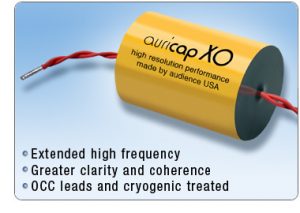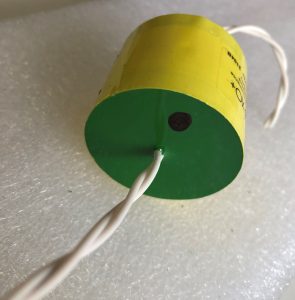
LEADS
Auricap film capacitors are not polarized. However, Auricaps have an outside foil (side of capacitor marked with black dot) that is a very useful noise shield when input and output impedances are considerably different values and it is connected to the lower impedance.

1) In all coupling applications the input to the Auricap should be the outside foil and connected to the signal source or circuit output with the opposite lead/inside foil continuing on to the next circuit input.
2) In all power supply decoupling applications the outside foil should be connected to ground and the opposite lead/inside foil connected to the voltage to be decoupled. This is true for decoupling either voltage polarities.
3) In loudspeaker crossover applications, if the Auricap is in series, like feeding a tweeter, the outside foil connects to the input binding post and the opposite lead/inside foil connects to the tweeter. Where the Auricap is in parallel, as typically used for woofers, the outside foil connects to the speaker connection that connects to the input binding post and the opposite lead/inside foil connects to the other speaker terminal. Follow these same rules for midrange connections where you will have a combination of both.
The idea is to always have the outside foil connected to the lower impedance to provide outside foil shielding to noise. Circuit outputs are always lower impedance than inputs and should be connected to the outside foil.
Auricaps will blossom during the first 50 hours of use as they break in for most applications. At first they will be a bit stuffy so please be patient to allow for the magic of these high quality audio grade capacitors to unfold. However, for use in electric guitars, for example, the signal level is so low it could potentially take years for break-in.
To greatly expedite the break-in of capacitors a 30v AC transformer of 25 watts of more can be used across the cap (out of circuit of course) for a minimum of 100 hours. For quicker break in a 60v transformer can be used or a minimum of 50 hours. It is okay to break in capacitors of differing values simultaneously with the transformer. It is also okay to break in large quantities of caps simultaneously.
BYPASSING
Do not use bypass capacitors in the signal path. A single capacitor for DC blocking/AC coupling creates a simple path with one time constant. The signal quality will be compromised if a bypass or multiple bypass capacitors are added to a signal path capacitor. Bypass capacitors were used in the past to bypass low quality film capacitors or electrolytic capacitors. The bypass was the lesser of two evils. With the advent of better quality film capacitors the need for a bypass capacitor was eliminated. Bypass capacitors create multiple signal paths with multiple time constants. These time constants are very short but they can still be heard as a smear or overall loss of focus.
Always bypass power supply capacitors. This maintains a low source impedance to the power supply over a wide bandwidth. If budget and space permit it is good to use multiple value power supply bypass capacitors with the smallest value being installed directly at the active device. (Tube or transistor.)
MATCHING
Audience will provide 1% matched pairs when it is requested for a charge of $1.50 per matched pair. The nominal tolerance is 10%. However, production tolerance is usually within 5%.
Matching will result in no audible benefit except in critical equalization circuits such as the RIAA equalization in a phonograph preamplifier. There is a common misconception that tolerance is somehow related to a capacitor's quality. When selecting capacitors for coupling, bypass or crossover networks there will be no audible benefit. However if you still want your Auricaps matched we will be happy to do so.
Description | Reviews | Dealers | A Chemist's View
Auricap Specifications | Auricap Applications | Auricap Application Notes
Keep Up With Audience
Mailing List- Newsletters and Press Releases





